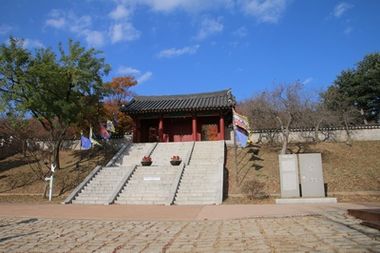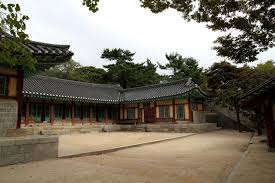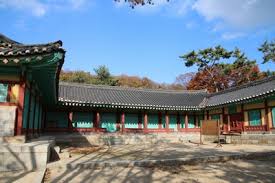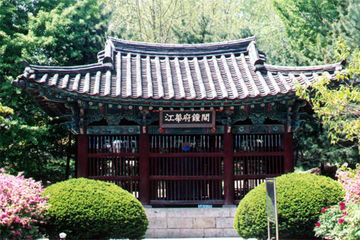강화고려궁지
| 강화 고려궁지 | |
|---|---|

| |
| 지정 번호 | 사적 제133호 |
| 지정일 | 1964년 6월 10일 |
| 지정 명칭 | 강화 고려궁지 |
| 한자 명칭 | 江華 高麗宮址 |
| 영문 명칭 | Goryeo Palace Site, Ganghwa |
| 분류 | 유적건조물 / 정치국방 / 궁궐·관아 / 궁궐터 |
| 건립·제작 | 고려시대 |
| 주소 | 강화군 강화읍 북문길 42 (관청리) |
| 위도 | 37.751994 |
| 경도 | 126.485334 |
| 웹사이트 | |
개관
한국어
강화 고려궁은 고려가 몽골군의 침략에 대항하기 위해 고종 19년(1232)에 강화도로 수도를 옮기고 1234년(고종19)에 세운 궁궐과 관아건물이다.
정궁 이외에도 행궁·이궁·가궐을 비롯하여 많은 궁궐이 있었다. 정문은 승평문이었고 양쪽에 삼층루의 문이 두 개가 있었으며 동쪽에 광화문이 있었다. 39년동안 사용되었고 1270년 강화조약이 맺어져 다시 수도를 옮기면서 허물어졌다. 조선시대에도 전쟁이 일어나면 강화도를 피난지로 정했다. 조선 인조 9년에 옛 고려 궁터에 행궁을 지었으나 병자호란 때 청군에게 함락되었다. 그후 다시 강화유수부의 건물을 지었으나 병인양요 때 프랑스군에 의해 거의 불타 없어져 지금은 강화유수부 동헌과 강화유수부 이방청만이 남아있다.
이 곳은 끊임없는 외세의 침략에 저항한 우리 민족의 자주정신과 국난 극복의 역사적 교훈을 안겨주는 곳이다. [1]
영어
Goryeo Palace Site, Ganghwa is a palace and a building site built by Goryeo in 1234, after moving the capital to Ganghwa Island in the 19th year of King Gojong's reign (1232).
Besides the palace, there were many other palaces, including Haenggung, Yigung, and Gagung. The main gate was Seungpyeongmun, with two doors on each side of the third floor and Gwanghwamun Gate on the east. It was used for 39 years and was torn down in 1270, when a peace treaty was signed and the capital was relocated again. During the Joseon Dynasty, Ganghwa Island was designated as a refuge in the event of war. In the ninth year of King Injo's reign, Haenggung was built in the old Goryeo court, but it was taken over by the Qing army during the war. After that, the building of Ganghwa Yudubu Department was built again, but only Dong-heon and Yi Bang-cheong were burned down by the French military during the Byung-in Yang-yo period.
It is a place that offers historical lessons for the Korean people's self-reliance spirit and overcoming national difficulties, which have resisted constant foreign invasion.
지도
해설
고려궁의 구조 및 잔여건물 / Structure and Remaining Building of Goryeo Palace
강화 고려 궁정의 건물로는 본궁인 연경궁(延慶宮), 그 북동쪽 언덕에 강안전(康安殿), 소동문을 들어가 성마루터 북쪽에 경령궁(景靈宮), 옥림리 자문고개 서쪽에 건덕전(乾德殿), 그 동쪽에 장녕전(長寧殿), 뒤쪽에 만녕전(萬寧殿), 그리고 북창문 밖의 대묘동에 태묘전각(太廟殿閣)으로 대관전(大觀殿)과 신격전(神格殿)이 있었다고 하나 현재는 모두 없어졌고, 이 밖에 이궁(離宮)과 가궐(假闕)도 곳곳에 세웠다고 하는 것으로 보아 그 규모가 방대하였음을 알 수 있다. [2]
현재 강화 고려궁지라고 부르는 곳이 정궁(正宮)이 있었던 자리로 추정되며 비록 규모는 작았으나 궁궐을 송도의 궁궐과 비슷하게 만들고 궁궐의 뒷산 이름도 송악(松岳)이라 하였다. 궁의 정문 이름은 승평문(昇平門)이었고, 양측에 삼층루의 문이 두개가 있었으며 동쪽에 광화문(廣化門)이 있었다. 강화 고려궁은 1270년(원종 11)에 고려가 개경으로 환도할 때 모두 허물어졌다.
조선시대에 들어 1631년(인조 9)에 고려궁지에 행궁을 건립하여 국난시 이용하고자 하였다. 또한 강화유수부, 외규장각, 장녕전(萬寧殿), 만녕전(萬寧殿) 등을 세웠으나 병인양요 때 프랑스군에 의하여 거의 소실되었다. 현재 조선시대 관아 건물인 명위헌(明威軒), 이방청(吏房廳) 등과 복원된 외규장각이 남아 있다. [3]
외규장각
이방청
이방청
The buildings of Goryeo Palace include Yeongyeonggung Palace, Ganganjeon palace on the northeast hill, Gyeongnyeonggung Palace on the north side of the palace, Geondukjeon on the west side of the advisory gate of Okrim-ri, Mannyeongjeon on the rear, and Taegakjeon Hall on the Daemyo-dong outside the Bukchangmunmyo Shrine
The site of Ganghwa Goryeo Palace is presumed to have been the site of the palace. Although it was small in size, the palace was similar to the palace of Songdo, and the name of the mountain behind the palace was Songak. The main gate of the palace was called [Seungpyeongmun], with two doors on both sides and [Gwanghwamun] on the east. Ganghwa Goryeo Palace was demolished in 1270 (the 11th year of King Wonjong's reign) when Goryeo was restored to the palace.
In 1631 (the 9th year of King Injo's reign), Haenggung was constructed in Goryeo Palace and was intended to be used in the event of a national disaster. They also established [Strengthening Department], [Oegyujanggak], [Jangnyeongjeon], and [Mangnyeongjeon], but were almost destroyed by the French army during the time of illness. Currently, the restored Oegyujanggak remains with the government buildings of the Joseon Dynasty [Myeongwiheon] and [Gbangcheong].
강화유수부 동헌 / Magistrate’s Office of the Ganghwa Local Government
조선 시대 강화의 행정 책임자인 유수가 업무를 보던 중심 건물이다. 인조 16년(1638) 유수 김신국(金藎國)이 수리하였고, 영조 45년(1769) 유수 황경원(黃景源)이 현윤관(顯允觀)이라 하였다. 명위헌(明威軒)이라는 현판은 영조 때 명필인 백하 윤순(尹淳)이 쓴 것이다. 건물 구조는 정면 8칸, 측면 3칸의 팔작지붕 겹처마의 단층집으로 1977년 강화 중요 국방유적 복원 정화사업으로 정비되었다. 당초의 건물은 남아 있지 않고 현재의 건물은 1638년(인조 16)에 개수한 것이며, 그 뒤 퇴락한 것을 1977년 복원, 수리하였다.
This building was the magistrate’s office of the Ganghwa local government during the Joseon period (1392-1910). The exact construction period of this building is unknown. The building underwent several reconstructions and repairs. The current building was renovated in 1977.
강화유수부 이방청 / Personnel Clerk’s Office of the Ganghwa Local Government
강화유수부 안에 있는 6방(이‧호‧예‧병‧형‧공방)의 건물 중 이방의 집무실로 조선 중기의 관청 건물이다. 효종 5년(1654)에 유수 정세규(鄭世䂓)가 세웠으며, 정조 7년(1783)에 유수 김노진(金魯鎭)이 건물 내부를 고쳐 괘홀당(掛笏堂)이라고 불렀다. 나무로 된 1층의 기와집으로 ㄷ자형이며, 지붕 옆면은 여덟 팔자 모양의 팔작지붕으로 된 집이다. 여러 차례 고쳐서 옛날 관청의 모습을 잘 알 수는 없으나, 조선 시대 지방관아의 이방청을 살펴볼 수 있는 귀중한 자료이다.
This building was the personnel clerk’s office of the Ganghwa local government during the Joseon period (1392-1910). It was built in 1654 by Local Magistrate Jeong Se-gyu (1583-1661) and was later renovated in 1783 by Local Magistrate Kim No-jin (1735-1788). The building later underwent further reconstructions and repairs. [4]
고려궁지의 특징 및 의의 / Characteristics and significance of Ganghwa Goryeo Palace site
현재 강화 고려궁지라는 이름으로 문화재 지정이 되어 있으나, 실제 고려 궁궐의 모습은 남아 있지 않고 조선시대 관아 건물 몇 채만이 잔존해 있으며 복원된 외규장각이 있을 뿐이다. 비록 국난을 피하여 천도를 한 시기이기는 하지만 고려시대 정궁이 있던 자리로 의미가 있으며, 조선시대에 들어와서도 관아 건물 등으로 사용되며 지방 통치에 이용된 장소이고 정조가 추진했던 개혁의 일환이었던 외규장각이 건립된 곳이기도 하다.
고려시대, 조선시대를 거치며 외침으로 인한 국난을 극복하고자 했던 역사적 현장이기도 하다. 한편 강화 고려궁지의 위치와 범위에 대하여 많은 논의가 있었고, 현재도 논의가 진행 중이다. [5]Currently, it is designated as a cultural heritage site under the name of Ganghwa Goryeo Palace, but the actual palace of Goryeo is not left, and only a few buildings of Gwana during the Joseon Dynasty are still remaining, and there are only restored Oegyujanggak.
Although it was a time when the royal palace of the Goryeo Dynasty was located, it was also used as a building for the government during the Joseon Dynasty. It is also a historical site where people tried to overcome the difficulties of crying out during the Goryeo and Joseon periods. Meanwhile, there has been much discussion about the location and scope of Ganghwa Goryeo Palace, and there is still discussion going on.
시각자료
사진
전경
잔여건물
동종
참고영상
<대몽항쟁의 역사가 깃든 고려궁지> 문화재청. 2016. 9. 9.
출처
- ↑ 문화재청 국가문화유산포털 http://www.heritage.go.kr/heri/cul/culSelectDetail.do?pageNo=5_2_1_0&ccbaCpno=1332301330000
- ↑ 두산백과 https://terms.naver.com/entry.nhn?docId=1057436&cid=40942&categoryId=33537
- ↑ 한국민족문화대백과 http://encykorea.aks.ac.kr/Contents/SearchNavi?keyword=고려궁지&ridx=0&tot=3300
- ↑ 한국학중앙연구원 문화유산 영문 해설문 http://dh.aks.ac.kr/~heritage/wiki
- ↑ 한국민족문화대백과 http://encykorea.aks.ac.kr/Contents/SearchNavi?keyword=고려궁지&ridx=0&tot=3300
기여
일자 역할 이름 전공 2019.4. 정리 및 편집 손형남 인문정보학





